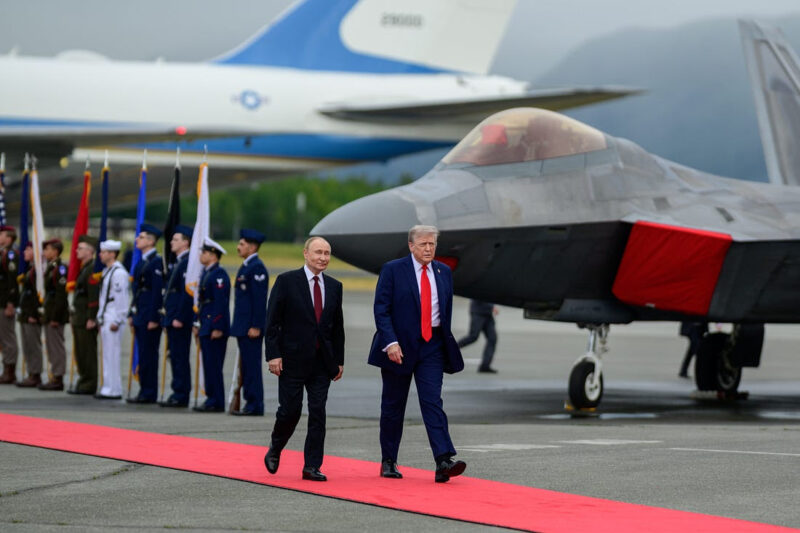 The much-anticipated meeting between U.S. President Donald Trump and Russian President Vladimir Putin concluded at Joint Base Elmendorf–Richardson in Alaska on August 15, 2025, marking the first face-to-face encounter between the two leaders since 2019. The summit was billed as a high-stakes diplomatic gamble aimed at charting a path toward ending the war in Ukraine — yet it ended without a formal agreement, instead producing what both sides described as an “understanding.”
The much-anticipated meeting between U.S. President Donald Trump and Russian President Vladimir Putin concluded at Joint Base Elmendorf–Richardson in Alaska on August 15, 2025, marking the first face-to-face encounter between the two leaders since 2019. The summit was billed as a high-stakes diplomatic gamble aimed at charting a path toward ending the war in Ukraine — yet it ended without a formal agreement, instead producing what both sides described as an “understanding.”
Setting the Stage
From the moment Putin stepped onto American soil — the first such visit in over a decade — the optics were striking. A red carpet welcome, a long handshake, and even a shared ride in the U.S. presidential limousine, “The Beast,” signalled warmth rarely seen in U.S.–Russia relations since the onset of Moscow’s invasion of Ukraine in 2022. The formalities aside, the real work took place behind closed doors over nearly three hours of talks, in a format that evolved from an expected one-on-one into a three-on-three meeting for greater oversight and broader input.
Joining Trump were Secretary of State Marco Rubio and special envoy Steve Witkoff, while Putin was flanked by Foreign Minister Sergey Lavrov and senior aide Yuri Ushakov. This change in format underscored the complexity of the issues at hand and the desire to have senior advisers ready to hammer out — or block — potential compromises in real time.
The Atmosphere and Tone
Both leaders emerged from the meeting projecting an air of cautious optimism. Trump characterised the discussion as “very productive” and reiterated his now-familiar line: “There’s no deal until there’s a deal.” Putin, for his part, called the exchanges “constructive” and “mutually respectful,” noting that the tone had been business-like yet cordial.
While they spoke of progress, neither provided details on what had been discussed, let alone agreed upon. The lack of specificity was deliberate — a way to keep diplomatic channels open while avoiding immediate political backlash in Washington, Moscow, Kyiv, or European capitals.
The Ukrainian Question
Putin acknowledged that the Ukrainian conflict was “one of the central issues” in the discussions. He reiterated that Russia is “genuinely interested” in ending the war and is ready to work on Ukraine’s security — statements that, while sounding conciliatory, have been met with scepticism in Kyiv and the West.
Trump noted his personal interest in resolving the conflict, framing himself as a potential dealmaker who could bridge the wide gulf between the combatants. He promised to brief NATO leaders and Ukrainian President Volodymyr Zelenskyy in the coming days, raising speculation about a possible three-way summit should conditions ripen.
However, there was no indication that Ukraine’s core demands — including the restoration of its 1991 borders and full withdrawal of Russian forces — were closer to being met. Nor was there any sign that Russia was willing to reverse its annexations of Ukrainian territory.
NATO, Europe, and the “Without Ukraine” Problem
One of the more sensitive undercurrents of the Alaska summit was the absence of Ukraine and key European allies from the table. The Biden-era mantra of “nothing about Ukraine without Ukraine” was clearly not in play. While Trump has stated his intention to keep NATO informed, European capitals will be watching closely to see whether Washington drifts toward bilateral arrangements with Moscow that could undermine collective Western negotiating leverage.
Putin, for his part, hinted that “European capitals should not create obstacles or try to derail the progress underway,” a comment likely aimed at pre-empting EU criticism or resistance.
The Broader Relationship
Beyond Ukraine, the two leaders touched on possible areas of cooperation — from trade, which Putin claimed had increased by 20 percent in recent months, to joint projects in information technology and space exploration. These remarks were designed to suggest that U.S.–Russia relations could be rehabilitated in parallel with progress on Ukraine, creating incentives for Moscow to remain engaged in talks.
Putin also signalled interest in a potential nuclear arms arrangement, though this received less attention than the headline Ukraine question. Trump did not elaborate, perhaps wary of overcomplicating the post-summit narrative.
Strategic Calculations
The “understanding” both men referred to is less a policy blueprint than a mutual recognition of the costs of continued deadlock — and the potential political benefits of being seen to try for peace. For Trump, brokering a ceasefire would be a signature foreign policy achievement in his second term. For Putin, securing a pause in hostilities on favourable terms could consolidate Russia’s territorial gains and ease the pressure of Western sanctions.
Yet, the road ahead is treacherous. Any U.S.–Russia alignment on Ukraine will face fierce opposition in Kyiv unless it preserves Ukraine’s sovereignty in meaningful terms. NATO members like Poland and the Baltic states are also likely to resist any deal perceived as rewarding Russian aggression.
Optics Versus Substance
The Alaska meeting succeeded in delivering dramatic visuals and a narrative of renewed engagement. It did not, however, yield tangible commitments or a timeline for further negotiations. For seasoned observers of high diplomacy, this is unsurprising: major breakthroughs are rare in a first encounter of this sort, especially after years of frozen ties and open conflict.
That said, the fact that the two leaders met on U.S. soil, held extended talks, and agreed to keep the dialogue going is itself a significant development. The challenge now lies in translating that political theatre into substantive steps toward ending the war.
What Comes Next
Trump’s immediate task will be to reassure Zelenskyy and NATO allies that Washington is not cutting a side deal with Moscow. His promised calls to European leaders and to Kyiv will set the tone for whether the “understanding” is seen as a diplomatic opportunity or a cause for concern.
Putin, meanwhile, will return to Moscow able to present the summit as proof that Russia is no longer isolated on the world stage. Whether that perception is accurate will depend on whether follow-on talks involve Ukraine directly and lead to verifiable changes on the ground.
A Calculated Pause in Hostility?
If the Alaska summit is to mark a real turning point, it must quickly move beyond generalities. This means agreeing on specific confidence-building measures — such as humanitarian corridors, prisoner exchanges, or limited ceasefires in certain sectors — that can demonstrate goodwill and build momentum.
The danger is that, without such steps, the “understanding” will fade into another missed opportunity, remembered more for its pomp than for its results.
Looking Ahead
The Trump–Putin meeting in Alaska was less about sealing a deal and more about re-opening a channel. It was a political icebreaker — an opportunity to test intentions, measure flexibility, and set the stage for future bargaining. For now, it leaves the war in Ukraine exactly where it was yesterday: brutal, unresolved, and costly.
But the mere fact of a respectful, extended dialogue between Washington and Moscow, after years of acrimony, is not nothing. In diplomacy, momentum often starts with atmospherics before moving to substance